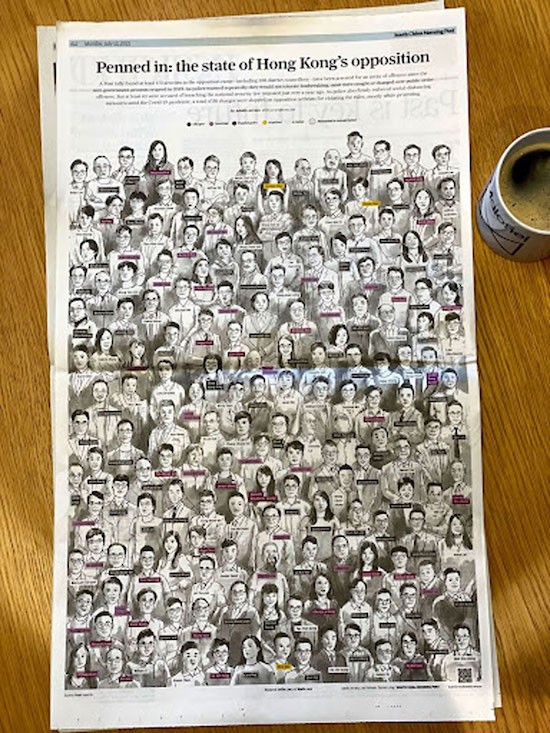A striking infographic provides Hong Kong newspaper readers with a unique visual record of the dozens of key activists caught in the fallout of Beijing’s sweeping national security law.
In an INMA ideas blog, South China Morning Post creative director Adolfo Arranz tells of the time taken to produce the hand-drawn illustration featuring members of Hong Kong’s opposition, highlighting Hong Kong’s embattled opposition camp.
The opposition camp had been a vocal and potent force until the imposition of the national security law in 2020. “Some prominent figures were jailed for participating in the Hong Kong 2019 anti-government protests, and some fled overseas,” says Arranz. “Others announced they had quit politics for good.”
The infographic began with a sketch, continuing earlier infographics projects about protests in the city that were sparked by a now-withdrawn extradition bill in June 2019. Opposition to the bill morphed into wider and often violent civil unrest, eventually leading to more than 10,000 arrests.
“For this project, key figures from the opposition camp were hand-drawn. That’s a lot of faces to draw, taking many painstaking hours.” But Arranz says it was done for a good reason.
“The photos we had access to came from different sources and in varying resolutions, colours, and quality. We believed a graphic with numerous headshots wouldn’t do this project justice.

Instead, we believed that doing illustrated portraits would give our project a stronger visual consistency, style, and unique identity. We saw it as an opportunity to convey a Hong Kong story of significant global interest in an informative and original way.
Images were scanned so illustrators could work on the project on a tablet, and a decision was taken to create a ‘spotlight’ pointer that readers could navigate to focus on people, one at a time. The pointer would reveal essential details such as their name, role, or affiliation, and if they were charged, convicted, jailed or acquitted.
“In addition, the use of the spotlight on a darker palette gave this infographic a sense of being in a confined space – as if the reader was peering into some sort of detention facility,” he says. “Readers could, if they wanted to, study details of the graphic for hours using the spotlight feature, examining each individual closely.”
The project started with identifying who was going to be in the graphic. This involved examining publicly available records and other information about ‘who, what, where.
That research, over several weeks, identified 180 people initially, many of them district councillors. For this, the graphics team worked closely with colleagues from the Hong Kong news desk, who were on the reporting frontlines during the protests.
Working on the drawing took about two weeks. Designers also had to make sure it worked on different versions (such as mobile, desktop and tablet).
Then came the drawing with pen and pencil. This was done first on a very long (200 centimetre) piece of paper. Then we scanned the hand-drawn images so we could move our editing to tablet and desktop, which made finer facial details and shading easier with Photoshop. Other project team members were Jeffie Lam, Dennis Wong, Ka Kuen Lau and Nadia Lam.
Working on the illustrations took almost two weeks, with one of the trickiest parts arranging the figures for different versions such as mobile, tablet, and desktop. A portion of the infographic was also dedicated to visually showing other key data related to Hong Kong laws.
“The positioning of people in the newspaper edition also took some time and we were pleased with the end result,” says Arranz. “The sketched figures matched the aesthetics of the Post’s print edition.”














Comments